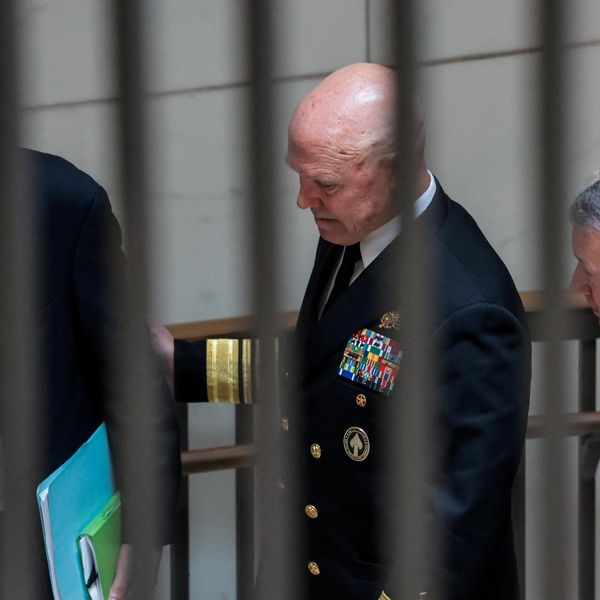Donald Trump ended his term in office just as he started it: lying about being “anti-war.”
During the 2016 election campaign, Trump rose to the top of a crowded Republican primary field by styling himself an insurgent outsider. A key component of this rebrand was the repeated insistence that he stood alone in the field as being anti-war.
Claiming (without evidence) that he had opposed the invasion of Iraq, Trump lambasted the bipartisan foreign policy establishment for its decades of disastrous militarism. For a war-weary nation desperate for change, this was evidence enough that Trump would be different. The “anti-war” label stuck, and it would be repeated over and over, up to the very final days of his presidency.
But with four years of accumulated evidence all pointing in the same direction, it’s time to kill this myth once and for all. Sure, Donald Trump didn’t launch a new all-out ground invasion on the scale of Iraq. But he did escalate conflict in every theatre of war he inherited, repeatedly brought the country to the brink of new wars, and recklessly threw around U.S. power with no regard for the many lives it would cost. The “anti-war” candidate, like those before him, was a pro-war president.
Escalating Inherited Wars — Despite repeated PR stunts, Trump did not “bring the troops home” or “end endless wars.” In fact, Trump consistently added fuel to the fire, increasing troop levels, deepening reliance on private contractors, and dramatically scaling up aerial warfare. Where an end to endless war requires repealing the 2001 and 2002 Authorizations for Use of Military Force, Trump expanded conflicts under both. His term saw four consecutive years of growth of an already out-of-control Pentagon budget. And loosening even the minimal restrictions that were already in place, he expanded the United States’ deadly and unaccountable drone wars.
Not only did Trump not end the wars he promised to, he worsened them, dropping more bombs, stoking further conflict, undermining the prospects of peace, and massively increasing the rate of civilian deaths.
All in on Yemen — U.S. support for the Saudi- and UAE-led intervention in the war in Yemen is one of the most egregious examples of destructive militarist foreign policymaking in years. Not only did Trump do nothing to end U.S. complicity himself, he repeatedly used his veto power to override bipartisan majorities in Congress that tried to stop U.S. military involvement and block the flow of arms to the conflict.
“Maximum Pressure” — Trump’s foreign policy was characterized above all by an aversion to diplomacy and a knee-jerk reliance on hostility. Attacking diplomatic relations and torpedoing successful multilateral agreements like the Iran nuclear deal, Trump instead tried to strongarm other countries into doing his bidding through threatening rhetoric, military brinkmanship, and suffocating sanctions. The result? Not a single one of Trump’s targets for hybrid warfare is any closer to doing his bidding now than when he started (often for the best). In the meantime, countless thousands have suffered the consequences.
Brought to the Brink — On multiple occasions, this hostile posture almost ignited all-out war. It was hardly a year ago that Trump’s illegal assassination of Iranian General Qasem Soleimani brought our countries to the brink of catastrophe. Ultimately, it was the pressure of mobilization by millions of people across the United States, Iran, and beyond, combined with restraint from the Iranian government, that averted that disaster. Trump deserves no praise for the fact that a crisis of his own creation didn’t spiral further out of control.
Nuclear War — Trump shredded the Intermediate-Range Nuclear Forces Treaty, withdrew from the Open Skies Treaty that ensured transparency between the U.S., much of Europe, and Russia, and failed to extend the critical New START Treaty with Russia. He took an inconsistent, self-serving, and often antagonistic approach to negotiations with North Korea that nearly took us to nuclear war. Oh, and he wanted to nuke hurricanes. In short: the world is closer to nuclear war than it was before Trump took office.
The War at Home — Communities of color have suffered under the thumb of police violence and “security” surveillance since well before Trump. But Trump took these wars even further, escalating Islamophobia, terrorizing migrants and asylum-seekers at the Southern border, violently repressing racial justice protesters, and so much more.
But these points are just the highlights. From selling weapons to dictators, to trying to launch a new drone war in Kenya, to stoking a Cold War with China, the list of reasons Trump is undeserving of the “anti-war” title is endless. The roots of U.S. military violence extend far beyond Trump, but there can be no doubt: Donald Trump’s foreign policy legacy is nothing but violence, suffering, and conflict.
Trump’s undeserved label is attributable to a basic but insidious mistake. For decades, U.S. foreign policy has been motivated by the belief in a U.S.-underwritten world order: The United States would be the supreme global power. It would use its power to create a rules-based system of liberal capitalist global governance (though the United States itself would largely be exempt from those rules). It would then promote and protect this order by the barrel of a gun.
To commentators unable to see beyond this ideology, the fact that Trump would attack international institutions like NATO or the World Trade Organization was evidence that he was rejecting the whole project, turning America inward toward “restraint” and “isolationism.” In reality, while Trump denied the first half — eschewing internationalist cooperation or rulemaking — he maintained the latter, continuing to use violent force abroad on a whim when he thought that it would be to the national benefit. In short, he was a national chauvinist, completely fine with military adventurism, but opposed to even a whiff of multilateralism.
But if the pre-Trump status quo means international engagement and endless war, and the Trump doctrine is nationalism and endless war, what’s the alternative? We must return to the task of multilateral cooperation and rulemaking — but this time, it must be in pursuit of an order that benefits all equally, which no single country sits above, or promotes by violent force. Rather than an order designed to maximize profits, this must be an order rooted in shared rules, in justice, in equity, and in the liberation of all.
Trump was never anti-war. Not when he was a candidate, and not after four years in office. But there’s a reason his attacks on the pro-war establishment took hold. The people are tired of the status quo. We want change. Now is our chance to make it.
















